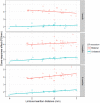Correlation between the Limbus-Insertion Distance of the Lateral Rectus Muscle and Lateral Rectus Recession Surgery in Intermittent Exotropia
- PMID: 27463100
- PMCID: PMC4962984
- DOI: 10.1371/journal.pone.0160263
Correlation between the Limbus-Insertion Distance of the Lateral Rectus Muscle and Lateral Rectus Recession Surgery in Intermittent Exotropia
Abstract
The aim of this study was to investigate whether the limbus-insertion distance (LID) of the lateral rectus (LR) muscle can be a useful indicator for predicting the surgical effect of recession surgery in intermittent exotropia (IXT). Patients who underwent unilateral or bilateral LR recession for the basic type of IXT were included. The distance between the corneal limbus and the posterior edge of the insertion of LR muscle (limbus-insertion distance) was measured intraoperatively using surgical calipers (graded with 0.25 mm precision). We calculated the actual dose-response effect as the difference between the angle of preoperative deviation and the angle of postoperative deviation, and then divided the figure by the total amount of recession at postoperative months 1, 3, and 6. The correlation between the limbus-insertion distance (LID) of LR muscle and each dose-response effect was statistically analyzed. A total of 60 subjects were enrolled in this study. The mean LID of LR muscle was 5.8±0.7 mm. The dose-response effect was 3.2±1.0 prism diopters (PD)/mm at postoperative month 1, 3.4±1.0 PD/mm at postoperative month 3, and 3.4±1.1 PD/mm at postoperative month 6. The LID of the LR muscle was significantly correlated with dose-response effects in cases of unilateral and bilateral LR recession at postoperative months 3 and 6 (P = 0.01, <0.01, 0.04 and <0.01 respectively). As the LID of the LR muscle increased by 1 mm, the dose-response effect increased by 0.2PD/mm in unilateral LR recession, and by 0.4 PD/mm in bilateral LR recession at postoperative month 6. In conclusion, the LID of the LR muscle can be used as one predictor of the recession effect to assist in surgical planning for IXT. Moreover, undercorrection at the time of LR recession might be considered in patients with long LID of the LR muscle.
Conflict of interest statement
Figures
Similar articles
-
Surgical outcomes according to distance between preplaced suture and muscle insertion in lateral rectus recession.Eur J Ophthalmol. 2018 May;28(3):253-258. doi: 10.5301/ejo.5001045. Epub 2017 Oct 14. Eur J Ophthalmol. 2018. PMID: 29077187
-
Effects of unilateral lateral rectus recession according to the tendon width in intermittent exotropia.Eye (Lond). 2006 Jul;20(7):785-8. doi: 10.1038/sj.eye.6702002. Epub 2005 Jul 8. Eye (Lond). 2006. PMID: 16021187
-
Comparison of Surgical Outcomes with Unilateral Recession and Resection According to Angle of Deviation in Basic Intermittent Exotropia.Korean J Ophthalmol. 2015 Dec;29(6):411-7. doi: 10.3341/kjo.2015.29.6.411. Epub 2015 Nov 25. Korean J Ophthalmol. 2015. PMID: 26635458 Free PMC article.
-
Efficacy of bilateral lateral rectus recession versus unilateral recession and resection for basic-type intermittent exotropia: a meta-analysis.Acta Ophthalmol. 2021 Nov;99(7):e984-e990. doi: 10.1111/aos.14726. Epub 2021 Feb 11. Acta Ophthalmol. 2021. PMID: 33576184
-
Bilateral lateral rectus recession versus unilateral recession/resection for basic intermittent exotropia.Medwave. 2018 Oct 29;18(6):e7319. doi: 10.5867/medwave.2018.06.7318. Medwave. 2018. PMID: 30395563 Review. English, Spanish.
Cited by
-
How to Better Treat Patients with Intermittent Exotropia: A Review of Surgical Treatment of Intermittent Exotropia.Korean J Ophthalmol. 2022 Dec;36(6):550-564. doi: 10.3341/kjo.2022.0043. Epub 2022 Oct 11. Korean J Ophthalmol. 2022. PMID: 36220643 Free PMC article. Review.
-
Surgical management of intermittent exotropia: do we have an answer for all?BMJ Open Ophthalmol. 2019 Mar 8;4(1):e000243. doi: 10.1136/bmjophth-2018-000243. eCollection 2019. BMJ Open Ophthalmol. 2019. PMID: 30997406 Free PMC article. Review.
-
Factors affecting residual exotropia after two muscle surgery for intermittent exotropia.Int J Ophthalmol. 2017 Jul 18;10(7):1120-1125. doi: 10.18240/ijo.2017.07.16. eCollection 2017. Int J Ophthalmol. 2017. PMID: 28730116 Free PMC article.
References
-
- Ing MR, Pang SW. The racial distribution of strabismus. A statistical study. Hawaii Med J. 1974;33: 22–23. - PubMed
-
- Mohney BG, Huffaker RK. Common forms of childhood exotropia. Ophthalmology. 2003;110: 2093–2096. - PubMed
-
- Nusz KJ, Mohney BG, Diehl NN. The course of intermittent exotropia in a population-based cohort. Ophthalmology. 2006;113: 1154–1158. - PubMed
-
- Chia A, Seenyen L, Long QB. A retrospective review of 287 consecutive children in singapore presenting with intermittent exotropia. J AAPOS. 2005;9: 257–263. - PubMed
-
- Scott WE, Keech R, Mash AJ. The postoperative results and stability of exodeviations. Arch Ophthalmol. 1981;99: 1814–1818. - PubMed
Publication types
MeSH terms
LinkOut - more resources
Full Text Sources
Other Literature Sources
Medical
Research Materials


